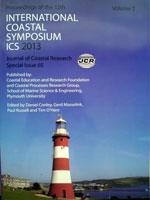Albuquerque, M., Espinoza, J., Teixeira, P., de Oliveira, A., Corrêa, I., Calliari, L., 2013. Erosion or Coastal Variability: an evaluation of the DSAS and the Change Polygon methods for the determination of erosive processes on sandy beaches.
There has recently been growing concern about issues related to erosive processes on sandy beaches and climate change in the scientific community. Several methodologies have been proposed in the worldwide literature to quantify coastline retreat on shorelines in an accurate way. It has been questioned whether these methodologies show the erosive process or the shoreline variability in a certain area. From this perspective, this paper aims at characterizing the accuracy of the Digital Shoreline Analysis System (DSAS) and the Change Polygon Method in the studies of regression on shorelines which are prone to erosion. Data collected by a GPS-RTK along Hermenegildo Beach, located in the south of Brazil, and the geo-referencing of satellite images enabled the outline of the shoreline in different periods with the use of both methodologies and the analysis of their accuracy. The DSAS showed good correlation among data; however, since it uses equidistant transects, it could not account for some features in the shape of crests or troughs in the area under study. The DSAS is based on the calculation of rates of statistical variations in a series of vector data that represents the shoreline. In order to correct those features that were not accounted for by the transects, more lines would have to be created so that a larger stretch of the area under study could be reached. The Change Polygon Method, based on the creation of polygons with lines from different periods, may be used to calculate the area of the region under study and compare it with areas from other periods. The calculated shoreline length led to the definition of the shoreline displacement in meters per year. The correlation was 13% (R2=0.131) in terms of reliability for the DSAS whereas it was 94% (R2=0.9418) for the Change Polygon Method, considering the same shorelines. Results showed that the Change Polygon Method is more reliable to evaluate variations in areas and shorelines by comparison with the DSAS. Choosing an efficient method to identify problematic areas with economic and social risks is fundamental to define strategies for proper management of places with erosive processes.





